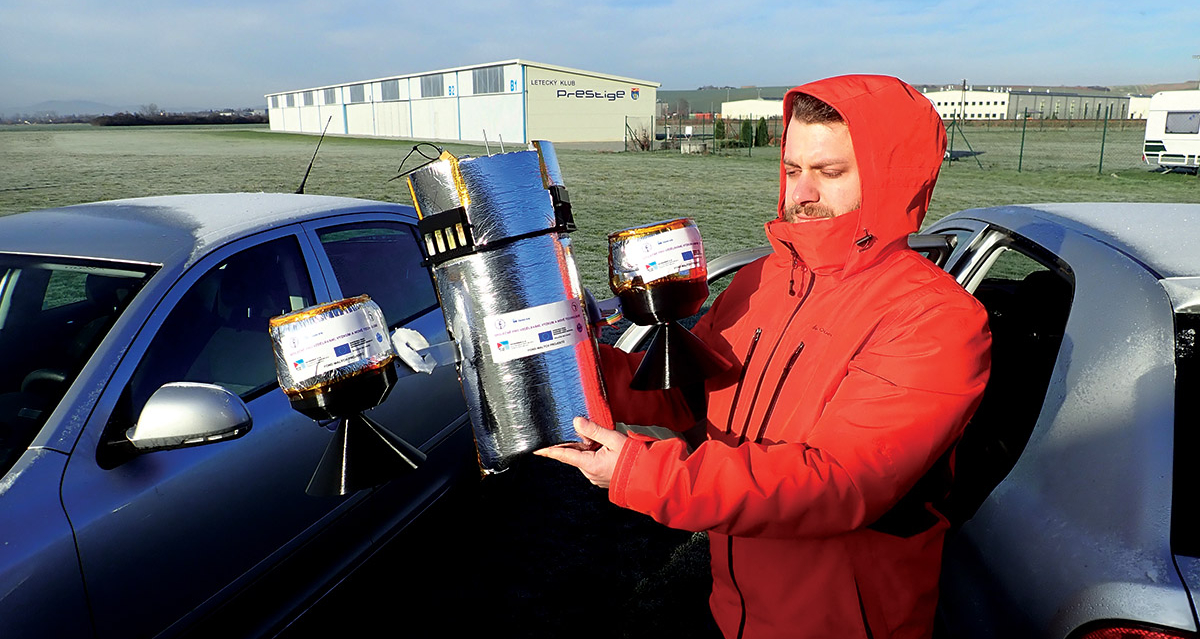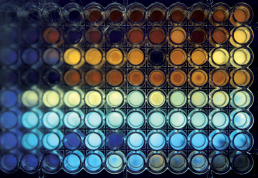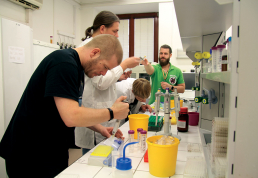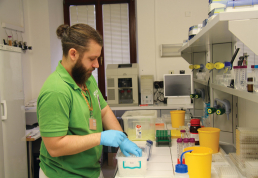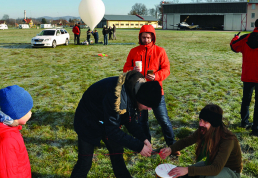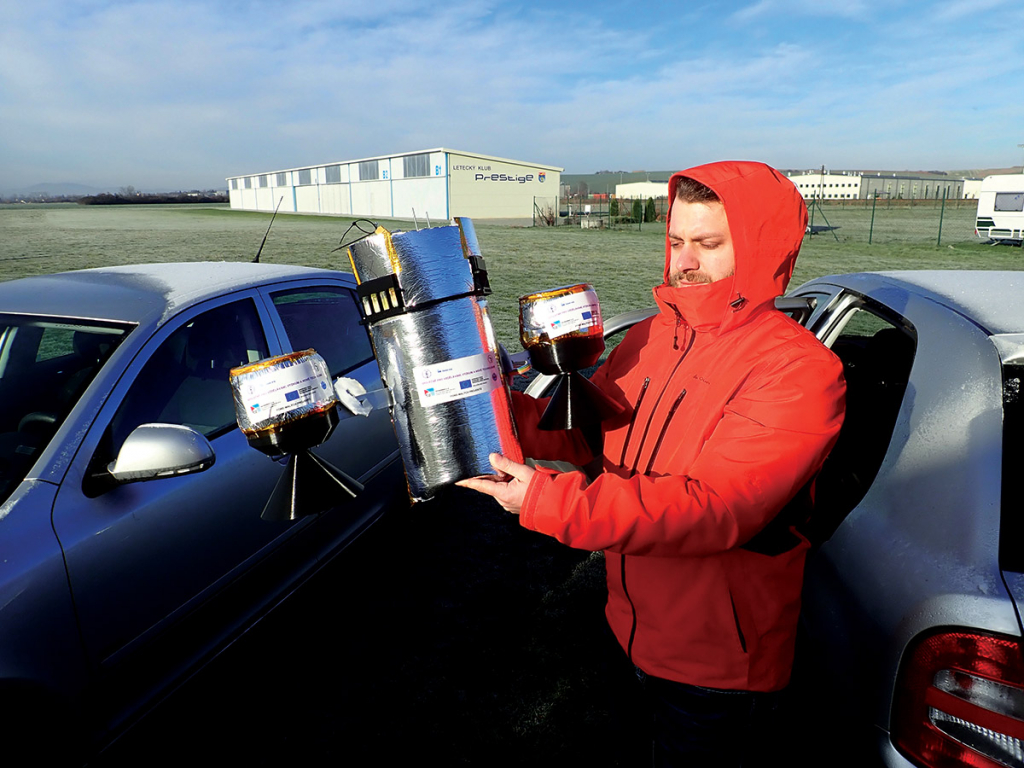
A project based on experiments carried by a balloon into the stratosphere can become a stepping stone to much bolder scientific achievements. “We are building the ground for larger and more distant targets, such as low orbit, space station or the planet Mars,” says Dr. Lukáš Nejdl, the Head of the Laboratory of Bioanalysis and Imaging, Department of Chemistry and Biochemistry, Faculty of Agriculture, Mendel University in Brno. Many years ago, our institute engaged in an interesting direction of research that uses flights into the stratosphere. Together with the Valašské Meziříčí Observatory and the Slovak Organization for Space Activities SOSA we are working intensively on experiments in the stratosphere, which may significantly affect the functioning of people in space in the future.
Your task is to prepare photochemical experiments for the stratospheric project. What are they?
These are chemical reactions that can be induced and controlled by light, ie electromagnetic waves. In our case, it is a mixture of reactants (precursors) containing metal ions and thiol groups. After irradiation with ultraviolet light, this mixture begins to react to form nanoparticles – quantum dots – about 2 to 8 nanometers in size. In general, quantum dots have unique fluorescence properties that can be studied by conventional spectroscopic instrumentation.
Is it difficult to prepare an attempt that will fly into the stratosphere? What does it involve?
It depends on what “optics” we look at. From my chemist’s point of view, it’s not very complicated. Just mix a few “waters”, check in the lab that it works, and that’s it! (smile) On the other hand, one must have an idea of what and why to mix. He must also be able to defend his experimental design. So know what it’s good for, give the experiment the right story. And it’s not just that anymore. In addition, everything must take place in collaboration with the designer and programmer, who provide all the necessary data on altitude, radiation conditions, temperature and the like. Without this data, even the best experiment will be useless.
What do you want to achieve with your attempts?
In general, I am trying to prove that on early Earth about 4 billion years ago, due to various physicochemical stimuli, such as temperature, ultraviolet radiation, body impacts and others, nanoparticles with different catalytic (nanosymatic) properties were formed. In my opinion, nanoparticles could, in the first phase of chemical evolution, catalyze important reactions leading to the formation of the basic blocks of life – nucleobases and amino acids. In the next phase, they may have played the role of nanozymes. That is, they mimicked the function of today’s enzymes and electron transport chains. Stratospheric experiments provide the opportunity to at least partially mimic the conditions on early Earth. In particular, it is a dynamic change of temperature up to about -60 ° C, radiation conditions also change significantly. With increasing altitude and due to the depletion of the ozone layer, the intensity of the so-called hard ultraviolet radiation, called UV-C, increases.
What will be the practical significance?
Again, it depends on how we look at the matter. One of the many questions of the origin of life is how the first biomolecules were, or could have been, protected from harmful ultraviolet radiation. Our latest data suggest that it was the reactions leading to the formation of quantum dots that may have contributed to the protection of the first biomolecules. Simply put, the harmful energy of ultraviolet radiation is used to create quantum dots. Even the quantum dots themselves effectively absorb ultraviolet radiation, so they can create a “UV shield”. In addition, the energy of ultraviolet radiation can be converted into chemical energy using quantum dots, and used there. The significance, then, lies in understanding the new mechanisms that may have led to the emergence or maintenance of first life on early Earth.
And the practical significance?
It lies in the fact that the acquired knowledge can be used, for example, to streamline the cultivation of algae in extreme conditions. There is a lot of thought now about what could be grown on Mars when humans colonize it. And it is the mechanisms we are studying that could make a significant contribution to this Martian “gardening.” Thanks to this research, algae in a bioreactor on Mars could survive harmful radiation and, in addition, use it more efficiently to create biomass, which can then be converted into food or fuel.
Have you ever worked on a similar task?
It was the first time during my doctoral studies, sometimes eight years ago. That was the first time I met Libor Lenža. He had black rubber boots, a camera around his neck, and he kept commenting on everything. (laughs) I am very glad that our cooperation has lasted until now and that Libor has become an integral part of our institute as well.
Is the preparation of such an experiment routine, or does one have to constantly concentrate?
I think it will be a routine for a small part, but certainly not the essential. In fact, one is constantly learning, trying to improve procedures, whether it is the design of an experiment, hardware or software. Colleagues from the Bratislava company Spacemanic have made enormous progress – thanks to them we can use technologies that are actually used for the construction of so-called nanosatellites of the CubeSat type. Colleagues Jan Zítka and Jan Šílený have created an incredible pair that can produce literally anything on a 3D printer, then install it with electronics, program it, test it and tune it. Everything I have described now is incredibly dynamic and requires the cooperation of each team member.
What if something still fails?
It is quite common for something to fail in science. It doesn’t work rather than it does. Science is very frustrating, so it’s probably not for everyone. The experiments that will be launched on the stratospheric balloon are independent of each other. So even if something goes wrong, some data will definitely remain. An extreme situation could occur if, for example, the balloon landed in the middle of a body of water or got far beyond the borders of Slovakia. In that case, it would be a big disappointment, but nothing worse would happen. In my opinion, the synergetic work of academics, companies and organizations is much more valuable. In our case, it is Mendel University in Brno, the aforementioned Spacemanic company and the Valašské Meziříčí Observatory.
Doesn’t it entice you to take off as well and perform your experiment in a space laboratory?
I’m definitely not going anywhere anymore, but if I could physically look into space, I would definitely want to be a part of it. (smile) As for experiments, I wish they’d made it into space. For example, our laboratory is a member of the ARIEL consortium. Its space mission, which will launch in 2028, will observe approximately 1,000 exoplanets to monitor the chemical composition of atmospheres, temperatures and the like. In addition, we participate in the ambitious project of the Czech satellite SLAVIA (Space Laboratory for Advanced Variable Instruments and Applications). In the near future, it will be decided whether to fly or not. We also plan to expand cooperation with the Brno company SAB Aerospace. There are definitely opportunities to get the experiment into space. You just need to be able to use them, that is, to be competitive. Balloon experiments significantly contribute to this effort. Through these projects and joint publications, the capacity for functional cooperation can be demonstrated, which is essential for larger and more ambitious projects.
Source: Valašské Meziříčí Observatory
